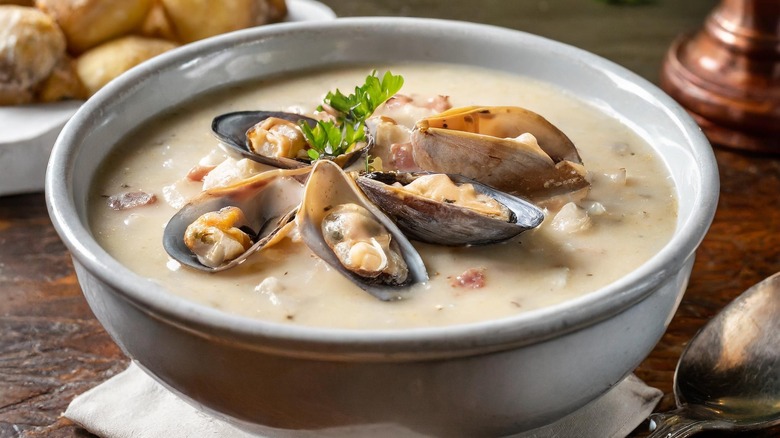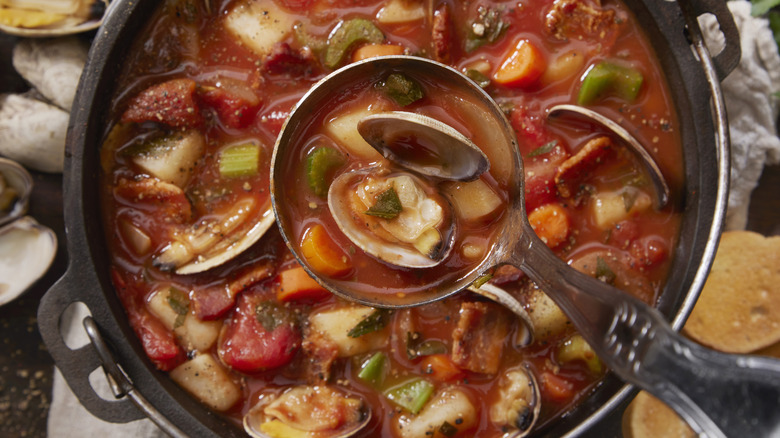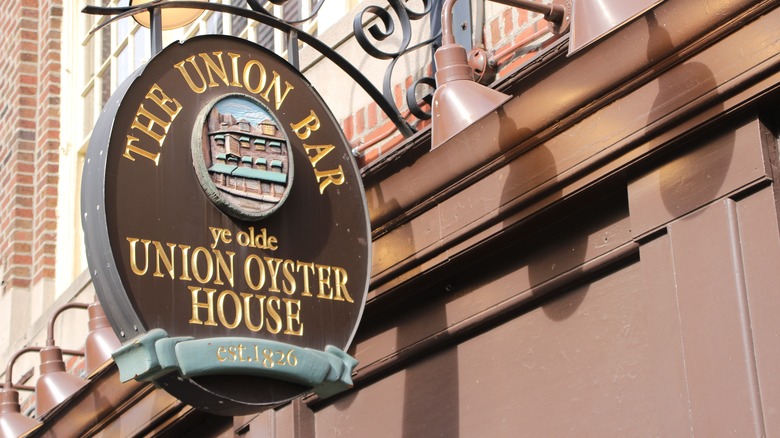One Man Hated Manhattan Clam Chowder So Much He Tried To Make It Illegal In Maine
New Englanders take their clam chowder seriously: Their version is appealingly creamy, with bacon, onion, potatoes, half-and-half milk, perhaps garlic and celery, and obviously, clams. (Despite the color, it doesn't always have cream, although some recipes call for it.) However, one ingredient that's definitely not in there is tomatoes. Tomato-based chowder is apparently such an affront that some New Englanders once attempted to make it illegal (at least in the Pine Tree State).
That soup is Manhattan clam chowder, and despite the name, it's linked to Portuguese immigrants in Rhode Island (though it does have a loose New York City connection — more on that later). In fact, one Maine legislator was so affronted by the concoction that he put forward a bill seeking to ban it from being served in the state. State representative Cleveland Sleeper, who hailed from the fishing town of Rockland, was apparently fixated on this. He put forward multiple bills on the issue in the years after his election in 1933. A bill in 1939 seems to have received the most attention, which would broadly ban any use of tomatoes in chowder (presumably this would apply mostly to restaurants, as it might have been difficult to police in private households). The proposed punishment? Offenders would have to go dig up a barrel of clams at high tide – effectively an unachievable task.
How the attempted ban unfolded
As it stands, you can safely make Manhattan clam chowder in Maine without the threat of arrest (although you may receive verbal abuse for it): Cleveland Sleeper's law did not pass. In fact, the bill never even made it to the floor of the legislature for a vote. Sleeper's motivation was a preoccupation with protecting Maine's cultural and culinary identity, at the expense of the outsider, Manhattan chowder. The proposed ban drew a lot of media attention at the time, and it's believed that it wasn't a joke or stunt, and that Sleeper was serious about his law. (The law likely wouldn't have succeeded, since its clam-digging punishment would likely be seen as inhumane.)
The dispute was resolved with a cook-off between two chefs at a hotel in Portland, with one preparing New England chowder and the other making it Manhattan-style. The New England version won, although this seems unsurprising, considering that the state governor was a judge.
There are rumblings online that a similar tomato-based chowder ban succeeded in Massachusetts, but sources referencing this are generally vague and don't provide any history or background on this "ban," so it seems likely that they're mixing up the two states.
Comparing the two chowders
Although only the creamy chowder is called "New England clam chowder," both versions actually originate from New England. The creamy version likely originated from French or British settler fisherman in the 1700s – one early recipe appeared in the Boston Evening Post in 1751. In 1836, it filtered through to restaurants, with the Union Oyster House in Boston being the first to serve it. The restaurant, one of the oldest in the country, is still open and dishing it up to this day.
Manhattan chowder came along a bit later. There are references to tomato-based chowders in numerous publications from roughly the mid-1800s onwards, although the "Manhattan" name didn't appear until 1934. While the dish is credited to Portuguese immigrants living in Rhode Island, the name is thought to come from their regular visits to the Fulton Fish Market in New York. The Manhattan version is generally thinner (James Beard described it as vegetable soup "with some clams dumped in it."), although there's still a surprising degree of overlap between the ingredients, as compared to the creamy iteration.
Both chowders obviously feature clams, but they also tend to have bacon (which tastes good with everything), plus potatoes, onions, and celery on their ingredient lists. It's really the base that's the biggest difference — tomatoes for Manhattan chowder, and cream or milk for the New England one. The Manhattan one may include more vegetables like carrots or peppers and tends to feature garlic and herbs more prominently.


